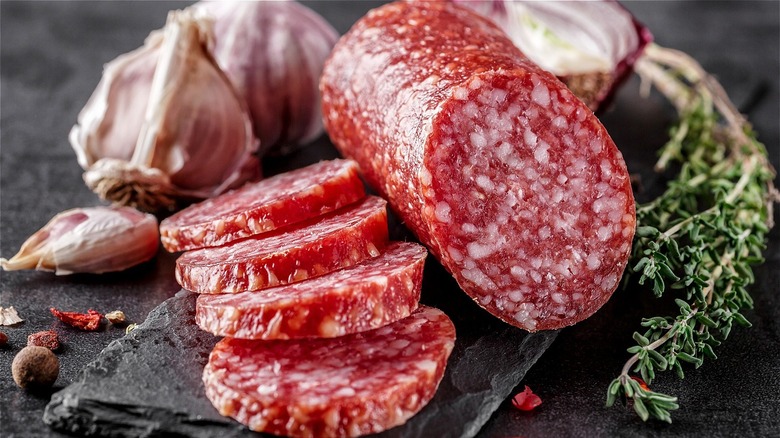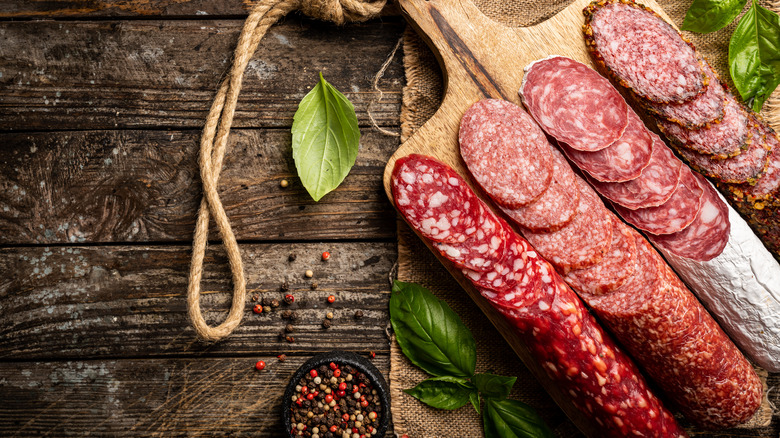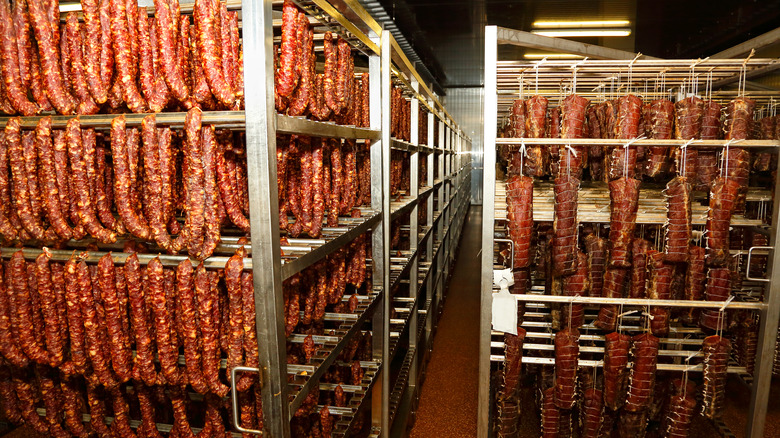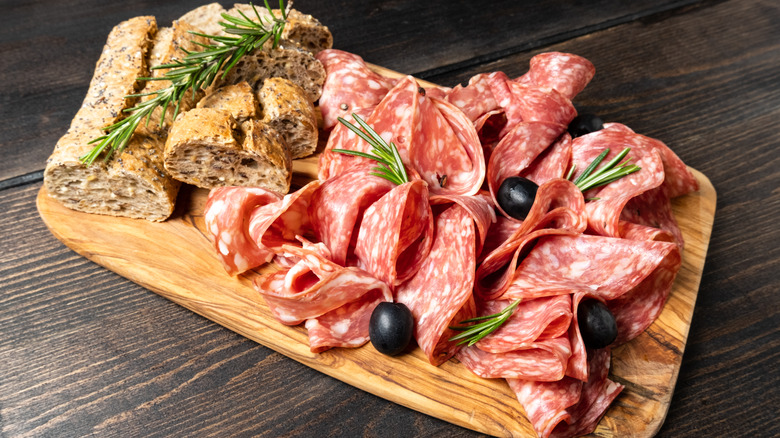What Is Salami And Is It Nutritious?
It seems like everyone and their mother has a favorite charcuterie product, and you'd be hard-pressed to find a meat lover who doesn't like a good slice of salami. The popular deli meat is as versatile as it is tasty. It keeps well, and it comes in enough varieties that you can change your favorite type every week and still be set for years.
However, salami is so ingrained in food culture that it can be easy to forget where exactly it comes from. We know off the top of our heads how our other favorite cured meat products are made: American-style bacon is famously cut from pork belly, while Italian prosciutto comes from the pig's hind leg (via Fine Dining Lovers). When it comes to salami, however, it can be difficult to say just what this compact, fat-speckled meat item really is, apart from pure deliciousness. How do these firm logs of salty, savory goodness come into existence?
What is salami?
According to Serious Eats, salami is in the Italian salumi family. (Yes, there's a difference.) While salumi refers to the general art of Italian meats, salami is a narrower term encompassing soft or fresh, cooked, and dry-cured meats — most commonly from pork, but also from beef, horse, and more. Italy is widely credited with having invented the product, and some date it back to Ancient Rome. As explained by Italy Magazine, a 1st-century A.D. Roman cookbook shows that pork salami has been around for centuries. A more modern version was later mentioned in an official Italian document in 1436.
If you're discussing salami in the U.S., you're probably talking about dry-cured pork sausage that comes in a firm, long log and is ready to eat when sliced. "Cured" means dried and preserved with salt. Salami's basic ingredients are pretty simple, consisting of various cuts of pork that are chopped, ground, and combined with salt and spices before being encased and left to cure.
How is salami made?
The first step in salami-making is selecting various cuts of pork and grinding them thoroughly, making sure there is a generous proportion of fatty bits in the mixture of leaner pieces, per British Charcuterie.live. Salt and flavorings, such as spices, garlic, herbs, or even nuts, are added to the mixture before it is stuffed into a case made out of the pig's cleaned intestines and then hung up to dry-cure. Now is when the delicate process of fermenting a tube of meat into proper salami can truly begin.
Dry-curing may be an ancient method, but it's actually a pretty scientific process, per the University of Melbourne. The sausage gets its distinct taste from strains of beneficial bacteria, which make the flavor more acidic and help result in salami's famously pleasant, chewy texture. Meanwhile, the salt pulls the excess moisture out of the meat. This is a time-consuming process that involves storing salami in strict temperature- and humidity-controlled conditions — very important, per Science Direct — for weeks, months, or years. As anyone who has tasted great salami can probably attest, the end result is worth it.
Cured vs. uncured salami
Now that you're familiar with salami's curing process, you might be confused about the "uncured" salami you may have seen at the grocery store. As MasterClass explains, "uncured meat is still cured," but with natural curing agents, such as salt, rather than preservatives. In the U.S., companies are legally required to label their meat products as "uncured" if they are made with natural curing agents.
On the other hand, salami listed as "cured" is preserved with salt and chemical additives, including sodium nitrite and sodium nitrate. Pepperoni, a type of salami, is a common example. Nitrites and nitrates occur naturally in the body and in several foods. When combined with protein, however, they can form nitrosamines, which may cause cancer, per Consumer Reports. When shopping for salami, pay attention to the packaging and ingredients list if there are any qualities you want to avoid.
What does salami taste like?
No matter which type you buy or how you enjoy it, all types of salami boast a similarly salty, porky taste and fatty mouthfeel. You may perceive the aroma to be acidic from the fermentation or reminiscent of aged cheese. Of course, more specific flavor notes depend on what is added to the salami. Some may have an anise flavor from fennel seeds, while others may taste spicy from black pepper or chili peppers. Those looking for a slightly sweeter, earthier flavor may want salami infused with wine or cinnamon.
If you're picking out some salami at the store, pay close attention to the seasonings and herbs listed on the packaging to give you a better idea as to what kind of flavor to expect. Plus, you can always ask someone at the deli counter for their recommendation if you have a specific use in mind for your salami.
How to serve salami
Though the salami you're most likely to buy is uncooked, that doesn't mean you have a lot of work cut out for yourself when you're ready to eat it. Thanks to its diligent fermentation and drying process, salami is preserved and can be eaten as is. Charcuterie board, anyone? If you want something more involved than a meat and cheese board, you can also add thinly sliced salami to sandwiches and pasta salads. For a crispy texture, it can be pan-fried and added to eggs or on pizza.
According to Life in Italy, the way salami is cut is just as important as what it's served with. Aim to cut softer, more delicate types of salami, such as soppressata, as thinly as possible to better appreciate its flavor and aroma. Reserve those thickly cut slices for hard, dry-aged salami to be enjoyed one bite at a time. There are countless ways to pair cured meats with cheeses, fruits, wine, and bread, but a good rule of thumb is to pair hard cheeses with spicy, dry salami and keep fresh fruits for soft salami. Volpi has a full guide with salami pairings centered around popular varieties like Genoa, Felino, finocchiona, and cacciatore.
Nutritional information about salami
Salami is not the leanest meat product on the market. The salty delight is high in sodium as well as fat, although its carb and calorie content rank low compared to those of other meats, a registered dietician explained via Healthline. Consuming salami regularly or in large amounts can pose some health consequences, as consuming too much sodium can lead to a spike in blood pressure. Moreover, any salted or cured meat is considered processed, which some organizations consider carcinogenic.
On the other hand, a low-carb snack, salami is high in protein, vitamin B12 and niacin (good for brain function and growth), and zinc, which can promote immunity and healing. Depending on the fermentation process, different kinds of salami can also act as a probiotic, aiding in digestion and heart health. As with all things, moderation is ideal. If you find yourself snacking on a lot of salami one day, you can always cut down on your sodium intake the next.
Where to buy salami
If you're in a hurry and just need a few slices of salami for a snack, you're probably aware that you can buy both whole logs and pre-sliced packages of salami at grocery stores, such as Trader Joe's and Whole Foods. However, if you can spare the time and a few extra bucks, you may be better off shopping for this cured meat item at a gourmet Italian or high-quality butcher shop. That way, you'll have access to meat professionals who know their products inside and out.
Butchers and deli specialists will be able to help you find the appropriate kind of salami, slice it properly, give you serving and storage instructions, and give you the exact amount you need to prevent waste. Plus, as Skip's Meat Market notes, butchers typically have a broader selection of fresher, higher-quality meats that may be less likely to contain unwanted preservatives. And it doesn't hurt that if you go to an Italian market, you'll have a good wine pairing waiting for you around the corner.







